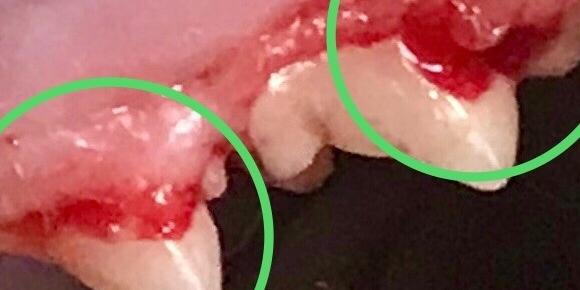Feline Oral Resorptive Lesions (FORLs)

- posted: Mar. 07, 2019
At Wascana Animal Hospital, we love seeing your cat family members for check-ups! A dental examination is done at the same time to assess the current level of gingivitis, periodontal disease and plaque that the patient may have. We all know that cats are masters at hiding illness and discomfort. One of the common "mouth" issues that we can see in cats are called feline oral resorptive lesions or FORLs.
These lesions can affect the enamel of the crowns (the white part of the tooth that is visible), the roots, or both. When this disease affects the enamel, it causes painful holes that their bodies often try to heal by filling in with granulation (reddish) tissue. Many of these teeth will also have associated gingivitis from the inflammation. Sometimes though, the enamel appears totally healthy and normal, yet underneath the gums the root is being resorbed which can again cause pain and fractures of the enamel above.
If you were to touch one of these lesions directly with your finger or a q-tip, our feline family members would react painfully; vocalizing, pulling away, or chattering their mouths (similar to the pain you feel with a cavity or sensitivity-ouch!). Despite the pain, many cats will still continue to eat and drink normally as again....they are masters at hiding it! This is why it is so important for your feline family members to have annual dental check-ups!
At Wascana Animal hospital, all of our dental treatment procedures include full mouth dental x-rays to make sure that even if things look good externally, we check what's happening below the gum line to make sure FORLs are not being missed. We want all of our patients to have healthy, pain-free mouths! Depending on the level of resorption present and where on the tooth it is occurring, extraction or crown amputations are required for treatment of FORLs.
FORLs can develop in cats independent of the level of plaque and periodontal disease present. There is still a lot of ongoing research into why these lesions develop in cats and at this time there appears to be possibly a genetic as well as environmental/nutritional component.
Often after having a dental treatment, our pet families tell us that "Fluffy is acting like a kitten again!" or "they are so much more playful!"...which tells us just how affected cats can be by these sneaky lesions. If you have any concerns about your cat's dental health be sure to schedule an examination with one of our veterinarians to find out more!

- posted: Mar. 07, 2019
At Wascana Animal Hospital, we love seeing your cat family members for check-ups! A dental examination is done at the same time to assess the current level of gingivitis, periodontal disease and plaque that the patient may have. We all know that cats are masters at hiding illness and discomfort. One of the common "mouth" issues that we can see in cats are called feline oral resorptive lesions or FORLs.
These lesions can affect the enamel of the crowns (the white part of the tooth that is visible), the roots, or both. When this disease affects the enamel, it causes painful holes that their bodies often try to heal by filling in with granulation (reddish) tissue. Many of these teeth will also have associated gingivitis from the inflammation. Sometimes though, the enamel appears totally healthy and normal, yet underneath the gums the root is being resorbed which can again cause pain and fractures of the enamel above.
If you were to touch one of these lesions directly with your finger or a q-tip, our feline family members would react painfully; vocalizing, pulling away, or chattering their mouths (similar to the pain you feel with a cavity or sensitivity-ouch!). Despite the pain, many cats will still continue to eat and drink normally as again....they are masters at hiding it! This is why it is so important for your feline family members to have annual dental check-ups!
At Wascana Animal hospital, all of our dental treatment procedures include full mouth dental x-rays to make sure that even if things look good externally, we check what's happening below the gum line to make sure FORLs are not being missed. We want all of our patients to have healthy, pain-free mouths! Depending on the level of resorption present and where on the tooth it is occurring, extraction or crown amputations are required for treatment of FORLs.
FORLs can develop in cats independent of the level of plaque and periodontal disease present. There is still a lot of ongoing research into why these lesions develop in cats and at this time there appears to be possibly a genetic as well as environmental/nutritional component.
Often after having a dental treatment, our pet families tell us that "Fluffy is acting like a kitten again!" or "they are so much more playful!"...which tells us just how affected cats can be by these sneaky lesions. If you have any concerns about your cat's dental health be sure to schedule an examination with one of our veterinarians to find out more!
Visit our Office
3259 Eastgate Drive
Regina, Saskatchewan S4Z1A4
